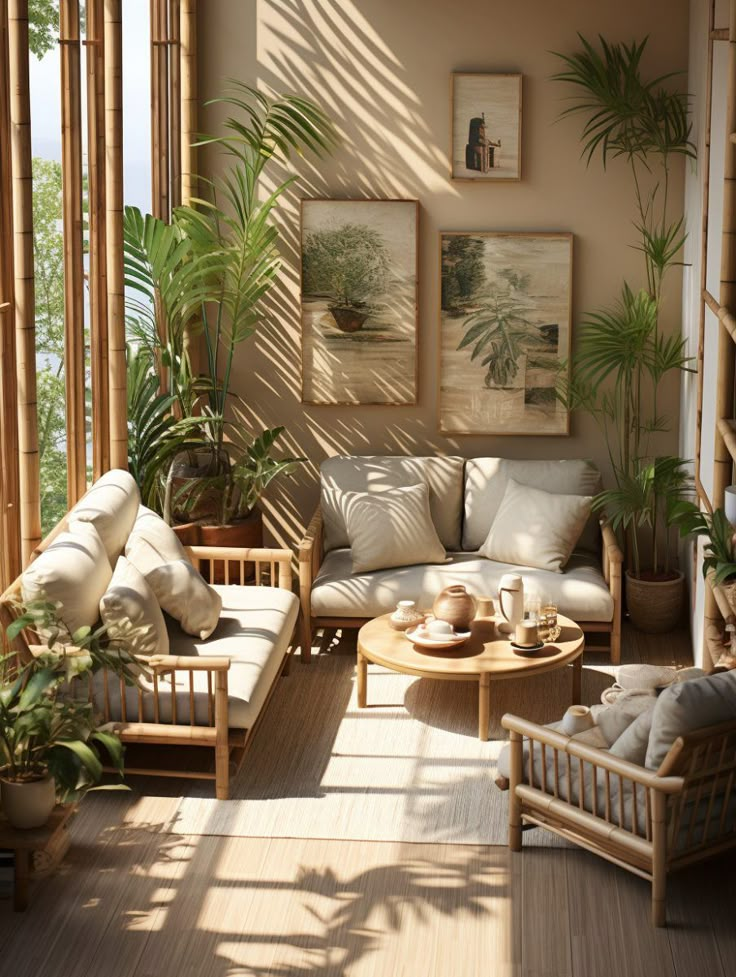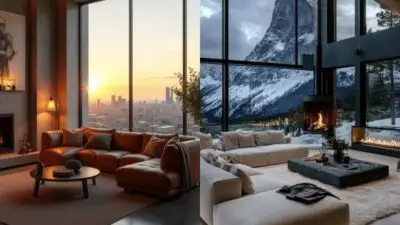Transforming your home into a sanctuary that reflects the beauty of nature can enhance your well-being and create a peaceful atmosphere. Nature-inspired interior decor integrates the calming elements of the outdoors, such as natural materials, greenery, and ample sunlight, into your living spaces. By filling your environment with these soothing features, you can cultivate a space that promotes tranquility and relaxation.
To achieve a harmonious blend of nature within your home, consider choosing materials that echo the organic textures and colors found outdoors. Incorporating plants not only beautifies your space but also improves air quality, making your home a healthier place to live. Utilizing natural light through strategic window placements can further enhance the inviting atmosphere, connecting you to the outside world.
As you explore the possibilities of nature-inspired decor, you’ll discover how simple changes can revive your space, turning it into a cherished retreat. Blending the essence of the outdoors with thoughtful decor choices can positively impact your daily life, making your home feel more alive and comfortable.



Key Takeaways
- Nature-inspired decor enhances your well-being by integrating organic elements.
- Incorporating plants and natural light improves both ambiance and air quality.
- Utilizing natural materials creates a cozy, inviting atmosphere in your home.
The Essence of Biophilic Design
Biophilic design centers around the connection between people and nature. This concept emphasizes how integrating natural elements into indoor spaces can enhance your well-being, balance, and creativity.
Principles of Biophilia
Biophilia revolves around the innate human attraction to nature. To harness this, you can use principles like natural light, organic shapes, and natural materials.
Consider incorporating large windows to invite sunlight into your home. This not only brightens your space but also enhances mood.
Use materials like wood and stone to create a tactile connection to the natural world. Plants are another key element, as they purify air and foster a sense of tranquility.
Incorporating water features, such as small fountains, can add soothing sounds that promote relaxation. Each of these elements aims to create harmony within your environment.
Benefits of Nature-Inspired Spaces
Integrating biophilic design can significantly enhance your mental and physical health. Studies indicate that spending time in nature or within nature-inspired environments can reduce stress and increase focus.
Spaces filled with natural light and greenery can also boost productivity and creativity.
You may find that incorporating plants into your decor leads to improved air quality, resulting in a healthier living space. The visual appeal of natural elements can create a calming atmosphere that encourages relaxation.
Furthermore, biophilic design fosters a deeper connection to the natural world. This connection can cultivate a sense of well-being, enriching your daily life and overall happiness.



Choosing Natural Materials
When it comes to nature-inspired interior decor, selecting the right natural materials can make a significant difference. The choice of materials not only influences aesthetics but also promotes sustainability and a connection with the environment. Here are some key materials to consider.
Wood and Reclaimed Timber
Wood plays a crucial role in creating warmth and texture in your space. From flooring to furniture, its versatility is unmatched.
Reclaimed timber adds history and character. You can find pieces with unique grains and colors, contributing to a more rustic and inviting feel. When choosing wood, opt for sustainably sourced options to reduce environmental impact.
Tip: Consider mixing different wood tones for visual contrast, while keeping the natural beauty intact.
Stone and Tiles
Incorporating stone into your home can enhance its natural look. Whether through countertops, flooring, or accent walls, stone brings durability and sophistication.
Consider materials like granite, marble, or slate, each offering unique textures and colors. You can also use natural stone tiles for an earthy touch.
Benefits:
- Durability: Stone surfaces resist wear and tear over time.
- Sustainability: Many stones are locally sourced, reducing transport emissions.
Natural Fabrics and Textiles
Utilizing organic materials for upholstery and decor is essential. Fabrics such as cotton, wool, jute, and silk create comfort while emphasizing nature’s beauty.
Cotton and linen are excellent choices for lightweight, breathable elements in your home. Wool provides warmth, while jute offers a natural, textured appeal in rugs or curtains.
When selecting textiles, look for those marked as organic to ensure they are free from harmful dyes and chemicals.
Tip: Layer different fabrics to create depth and richness in your decor.



Incorporating Plants and Greenery
Bringing plants into your space adds life and vitality. This section explores how to choose the right indoor plants, care for them effectively, and create a vibrant, lush atmosphere.
Indoor Plant Selection
Selecting the right indoor plants can enhance your decor significantly. Consider plants like snake plants, pothos, or peace lilies for easy care and aesthetic appeal.
Succulents are also a great choice for their unique shapes and vibrant colors. Choose a variety of sizes and shapes to create visual interest.
Botanical prints can complement your plant choices, tying the decor together beautifully. Remember to consider light levels and humidity in your space when making selections.
Caring for Indoor Plants
Caring for your indoor plants ensures they thrive and enhance your home.
Watering: Check the soil regularly. Most plants do well when the top inch of soil dries out. Overwatering can lead to root rot.
Light: Position your plants based on their light needs. Some thrive in direct sunlight, while others prefer indirect light.
Fertilizing: Use a balanced fertilizer during the growing season to promote lush greenery. Adjust as needed based on plant growth.
Creating a Lush Atmosphere
To achieve a rich, verdant atmosphere, group your plants together. This creates a mini indoor garden feel.
Consider using varied heights and styles. Tall plant stands or hanging planters add dimension.
Incorporate natural materials like wood and stone in your decor to enhance the botanical theme.
In addition, incorporate outdoor views by placing greenery near windows. This invites nature inside and creates a seamless connection between your indoor and outdoor space.



Natural Light and Air Flow
Embracing natural light and optimizing air flow are essential for creating a fresh and inviting indoor environment. By strategically incorporating sunlight and ensuring proper ventilation, you enhance the beauty and comfort of your space.
Maximizing Sunlight
To make the most of natural light, consider using large windows or expansive windows to capture the sun’s rays. Positioning these openings south-facing can help maximize sunlight exposure throughout the day.
In addition to standard windows, think about adding skylights. They not only brighten up dark corners but also provide a unique architectural element.
Using transom windows or glass doors can further invite sunlight into your home while maintaining a connection to the outdoor environment. To enhance the effect, choose light, reflective colors on walls and furniture, which can help bounce light around the room.
Ventilation and Air Quality
Proper ventilation significantly improves indoor air quality. Ensure that your home has adequate airflow by utilizing natural ventilation techniques. This may involve opening windows and doors to allow for fresh air.
In areas where air circulation is key, consider using ceiling fans to encourage movement. These fans can also create a pleasant breeze, enhancing comfort during warmer months.
Incorporating open floor plans can also facilitate airflow. Cross-ventilation can be achieved by aligning windows on opposite walls. This promotes a healthy exchange of air, reducing indoor pollutants and allergens while creating a breathable living space.
Decor Accents and Textures
Incorporating nature-inspired decor accents and textures brings warmth and life to your interior spaces. Focusing on earthy materials, organic patterns, and reflective surfaces can create a serene atmosphere, making your home feel connected to the environment.
Rugs and Flooring
Consider choosing rugs and flooring that echo natural elements. Look for options made from jute, sisal, or wool to introduce organic textures. These materials not only provide comfort but also add visual warmth.
Hardwood flooring is another excellent choice. Opt for wider planks with a natural finish to emphasize the beauty of the wood grain. Stains in muted tones maintain a grounded, earthy look that complements decor.
If you prefer something luxurious, explore options like natural stone tiles. Materials such as limestone or slate can enhance that organic feel while adding durability to high-traffic areas.
Patterns and Motifs
Patterns inspired by nature can significantly impact your decor. Consider botanical prints, floral motifs, or organic shapes on textiles, wall art, and furnishings. These designs create a sense of tranquility and invite the outdoors in.
You can also play with earthy color palettes. Choose hues like soft greens, rustic browns, and muted whites to tie your theme together seamlessly. Varying textures within these colors can create depth and interest throughout your space.
Incorporate natural patterns into accent pieces, such as cushions or curtains, to enhance comfort. You can even include geometric shapes that mimic natural forms for added contemporary flair.
Reflective and Water Elements
Introduce mirrors and water features to enhance your nature-inspired decor. Mirrors can amplify light and create the illusion of space, reflecting beautiful views or decor. Look for mirrors with wooden frames to maintain that organic aesthetic.
Water elements like indoor fountains or decorative bowls filled with water can also promote tranquility. The sound of flowing water adds a soothing ambiance, making your home feel like a serene oasis.
Consider placing these features near plants to enrich your indoor environment. The interplay of water, light, and greenery will create a cohesive nature-inspired sanctuary in your home.



Furniture and Color Schemes
Creating a nature-inspired interior involves thoughtful choices in furniture and color schemes to evoke relaxation and harmony. Focus on eco-friendly options and earthy tones to cultivate a soothing atmosphere in your home.
Selecting Eco-Friendly Furniture
When selecting furniture, prioritize pieces made from sustainable materials. Look for options crafted from reclaimed wood, bamboo, or recycled materials. These choices not only reduce your carbon footprint but also add unique character to your space.
Consider upholstery made from natural fibers like organic cotton or linen. Avoid synthetic materials that can emit harmful VOCs. Research brands committed to sustainability and ethical practices, ensuring your furniture aligns with your values.
Opt for multifunctional pieces, such as a coffee table with storage or a sofa bed, to maximize space while minimizing waste. This approach supports a minimalist, nature-inspired decor.
Earthy Color Palettes
Incorporate earthy color palettes to enhance your nature-inspired design. Think of deep greens, soft browns, and sandy beiges. These tones mimic natural elements, helping to create a serene environment.
Pale blue walls can create a calming backdrop, especially when paired with deep green sofas. Add touches of tan and white to lighten the space. Use these colors strategically to evoke feelings of relaxation and connection to nature.
Consider a palette inspired by your surroundings, such as the colors of a forest or desert landscape. Use these shades for larger furniture pieces or accent walls to create a cohesive look.
Integrating Nature-Inspired Decor
Accessorizing your space with nature-inspired decor elevates your interior design. Incorporate indoor plants for a burst of greenery. Plants not only purify the air but also add life to your decor.
Use botanical prints or nature-themed artwork to accent walls. These visuals can serve as reminders of the outdoors, enhancing your overall theme. Subtle, botanical-inspired cushions or throws can soften furniture and add texture.
Layer different materials, such as wood, stone, and textiles, to create visual interest. This combination reflects the diversity found in nature while promoting a cozy atmosphere. Choose decor that speaks to you, allowing your personality to shine through your nature-inspired sanctuary.
- 27shares
- Facebook0
- Pinterest27
- Twitter0


